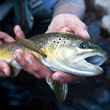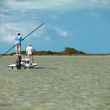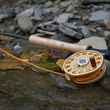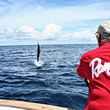Next time you stop into a fly shop, take a gander at the rod rack. Amongst the sea of expensive, often overly-stiff rods, you’ll probably spot the Redington Classic Trout. A rod that casts easily and pleasantly at practical fishing distances—and unlike the rocket launchers for sale beside it, you can buy a Classic Trout for $169.99.
As is typical for the rod market these days, the Classic Trout’s value has gone mostly unnoticed. Rod shoppers likely consider it a beginner or back-up rod, opting instead for the higher-priced rods that barely bend at ordinary fishing distances, even though such rods require more work to cast.
Fly rods store energy when they bend under the weight and momentum of the fly line. They release that energy as the rod straightens, propelling the fly line forward. A trampoline functions the same way: stretching to store energy under the weight of a person, then expending that energy as it launches the person up in the air. For many anglers, the smooth, energy-releasing sensation the hand feels as the rod unloads makes fly casting fun—it also makes casting easy on the arm. If a trampoline is too stiff to bend under our weight, we’ll have to work hard with our legs to make it bend. The same is true for our arms when a rod doesn’t bend.
Still, most fishermen tend to choose stiff, high-dollar rods. Why is this? Likely because of the marketing-grenades lobbed at us by the rod companies, leaving us so dazed that we believe we need their newest, high-end rod, simply because it’s new and expensive. They want us to assume that the price of a rod always correlates with its usefulness as a fishing tool. Fight this assumption.
Major rod manufacturers are forced to produce casting tools that follow market trends. Which means their most expensive rods usually meet the criteria of the most popular trend, whether or not that particular action provides pleasant casting. “Fast-action” rods—a euphemism for the unpleasant sounding “stiff rod” dominate today’s trends. Most of them are so rigid that they only bend when casting a very long line, as in sixty feet or further. Most of us rarely need to reach such distances when trout fishing. Yes, it’s true that these rods can be cast at shorter line lengths, but the experience feels more like casting a broomstick than a fly rod.
Stiff rods are specialized tools, best suited for casting long range. If this is a requirement in your fishing, or if feeling the rod load isn’t a priority for you, then by all means explore such rods. But if you seek a tool that actually contributes to the cast, one that is ideal for casting dry flies, nymphs and light streamers at fifty feet and under, consider the Classic Trout.
What Works
Action
Like most rods made by Far Bank Enterprises, the parent company of both Redington and Sage, the Classic Trout loads smoothly. Its fluid bend runs nearly all the way down to the cork, thus communicating valuable information to the caster. It bends similarly to smooth-casting Winston rods that have been lauded for decades—soft in the tip, stiffening gradually as the bend moves closer to the handle.

Craftsmanship
Weighing in at only 2.9 ounces, the five weight Classic Trout is lighter than some of the “advanced-technology” top-dollar rods. The relatively thin blank is a tasteful, dark-clay color, and its titanium-oxide stripping guides are durable and sleek. It’s hard to tell that it’s a low-budget rod if you’re judging by the blank and guides.
Price
At only $149.99, you can buy six Classic Trouts for the price of some of today's flagship rods. Buying one is practically stealing one.
Tippet Protection
The soft tip offers forgiveness when setting the hook on light tippet. You won’t snap fish off unless you truly bass-master them.
What Doesn’t
Distance
This soft-to-stiff, deep-bending action has a minor drawback: the rod tip is easy to shock when casting a long line—resulting in a tailing loop. The middle and lower sections of a rod always load by way of the rod tip, since the tip-top guide is the contact point between rod and the in-use fly line. Which is merely to say that the first foot of the rod must support its fair share of the load at whatever distance the rod is cast. The tip of the Classic Trout is vulnerable to shocking at distances beyond fifty feet, requiring a smooth stroke to cast it at long range. (This is the downfall of any fly rod that actually bends at normal fishing distances.) Not a big deal, but worth noting. Anytime you reach to a place where this rod bends severely, you’ll have to tread lightly.
Handle and Reel Components
Though the blank, guides and reel-seat look and feel great, I would describe the reel seat components as nothing more than “fine.” They look nice and function properly, but in the process of fastening down a reel, you can sense they are just bare-bones components, certainly not the solid, quality feel of more expensive hardware. The handle is slightly bulky, made of middle-of-the-road cork—it should be sanded to a thinner diameter for any caster that doesn’t have mega-mitts.
Final Word
This rod was likely dubbed the Redington Classic Trout because it bends similarly to the most popular rods of the 1970s. That was a fine era in rod building, when the trending rods were the same ones that cast nicely at practical fishing distances. In the forty years since, trends in the market have changed dramatically, but the fishing hasn’t. Whether you just need a cheap back-up rod—or you want a darn good fishing tool—pick up a Classic Trout while they’re still in production. You’ll rarely find a deal this good in our sport.

































Comments
Ethan Blase replied on Permalink
First rod I bought ever. Still use it. Stupidly good
Jock replied on Permalink
Hey Peter,
Great article, it's good to see that someone still has common sense in today's fly fishing industry. I really thought you did a good job explaining how a rod loads and stores energy; I had never heard it explain like that before, but it makes perfect sense! Keep up the good work!
Jim replied on Permalink
I build fly rods, but have found for my tastes there's not a better rod for floating a #16 dry fly into a pocket water pool at 20 feet. I also agree with you that the reel seat is basic at best. I had the reel seat fall apart when tightening up on the reel during one of the first times I used the rod. If you can manage to collect all the loose parts it can be easily epoxied back together - but anyone getting this rod should really cinch down on the reel in the shop to make sure it's been properly done. Thanks for a great article.
J Kim replied on Permalink
Very nice article, Peter. Love the physics behind the whole thing... ;)
Les Kish replied on Permalink
The three weight is a joy to cast and excels for "close in" work. It's been my "go to" rod since it hit the market. And, like Peter said, it's a heck of a deal. Try one and have some fun.
D. Lambroughton replied on Permalink
I got a set of this Classic Trout Model; 9 for 4, 9 for 5, and 9 for 6 that I leave in N.Z. for my visiting friends. They're been flawless, and like the Winston Rods you mentioned (my rods of choice) these inexpensive rods are quite similar in action. As a result, they perform extremely well at the the normal 25'-45' targets. I find it far more important for rods to cast and load well for shorter distances, than those "Pool Cues" that are often pushed and promoted.
Doug McNair replied on Permalink
This is an excellent and helpful review, especially with reference to the difference between the current fascination with fast action rods and the more classic actions. For those of us who learned on the classic action rods, and learned to cast well, the issues you mentioned isn't really a problem and the pleasure and advantages of the classic flex outweigh any disadvantage in throwing the long bomb.
I fish over 75 days a year for trout and do it all with two rods, a Walton Powell 9' 4/5 vintage 1989 and a Greys Streamflex Plus 9'6" 3 wt that I bought three years back. I never thought I'd like a rod as much as the Powell I've used for so many years but the Greys Streamflex Plus is awesome. What they both have in common is a "classic" or medium action with little distortion in the tip. I've been thinking about getting a Greys in a 4wt but it seems like a bit of gamble since the rod is no longer marketed here. I've "flex tested" the Redington CT and like what I've observed so far. Going to buy one now.
Thanks for your review.
El Truchador replied on Permalink
Can't agree more. I've got this rod in the 6 piece 8ft 3wt for long hikes, small water, and small flies; the 8.5 ft 4wt for long range dries and short range dry-droppers; and a 8.5ft 5wt for dry fly fishing when I'm targeting big fish on dries in fast current. My only high dollar rod is a Hardy Zenith 590 that I use as my Seven Iron when I don't know if I'll be chucking streamers or ripping a size 18 BWO into a New Mexico headwind. Can't say enough good things about the Classic Trout. If more people knew how good it was, half the premium rod companies would probably go out of business. There will always be a market for "status rods" but for sheer fishability you can't buy a better rod for the money.
Ethan Martin replied on Permalink
I have been fishing this rod for about a year and a half now and love it. At close range it is incredible! I own this rod in 9 foot 4 weight. I have used it in smaller streams and, as stated in the article, it loads really well for close range (normal) fishing conditions. Oddly enough, I even use this rod as one of my go-to nymphing rigs. The mid-flex action of the rod makes it possible to load a long leader system (mono-rig for me). I regularly cast leaders of up to 25 feet with this. Of course, it's not quite as sensitive and accurate as an actual 3 wt. 11 foot nymphing rod is, and I know because I have used them. However, I didn't originally purchase the classic trout for nymphing, I just thought I would give it a try, and it turned out to work shockingly well! I have been using it as my go-to nymphing rod for over a year now (I fish it once or twice a week). At the price point it is you truly have no reason why NOT to buy this rod. For me it has been two rods in one. I've been really pleased with the purchase!
Kerry replied on Permalink
Great article. I'd love to cast one of these. Here's an idea whose time should reprise: Why doesn't Farbank do the whole fly fishing world a favor and just re-issue the Sage XP? It is and was the most universally fine trout rod ever commercially made. Completely effortless casting, perfect for dries to streamers, loads beautifully, roll casts just fine, launches the hero cast when necessary. Not a broomstick like the RPL I got rid of when I bought my XP, but not an IM6 Winston either. Bring back the XP!
Pages